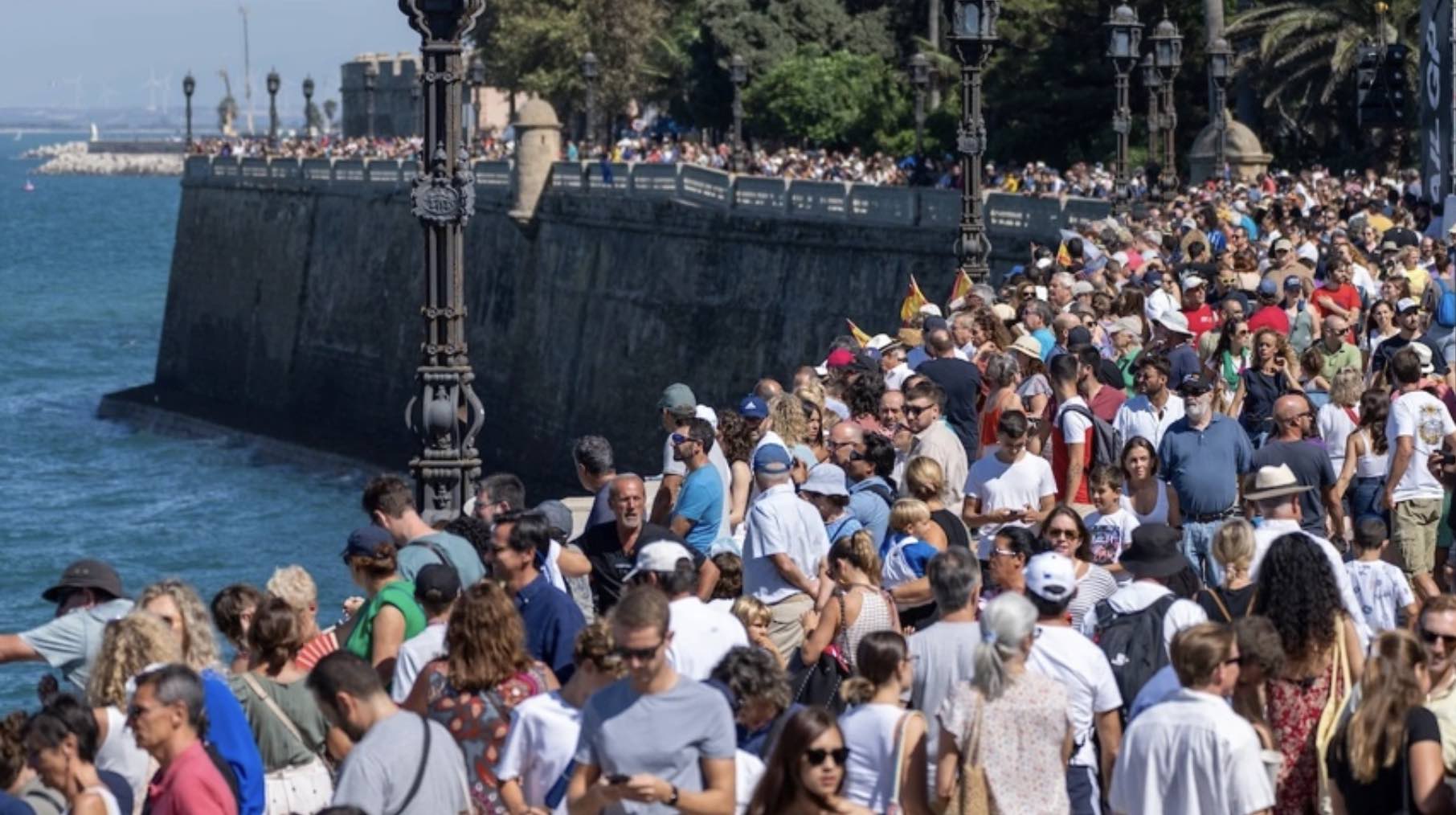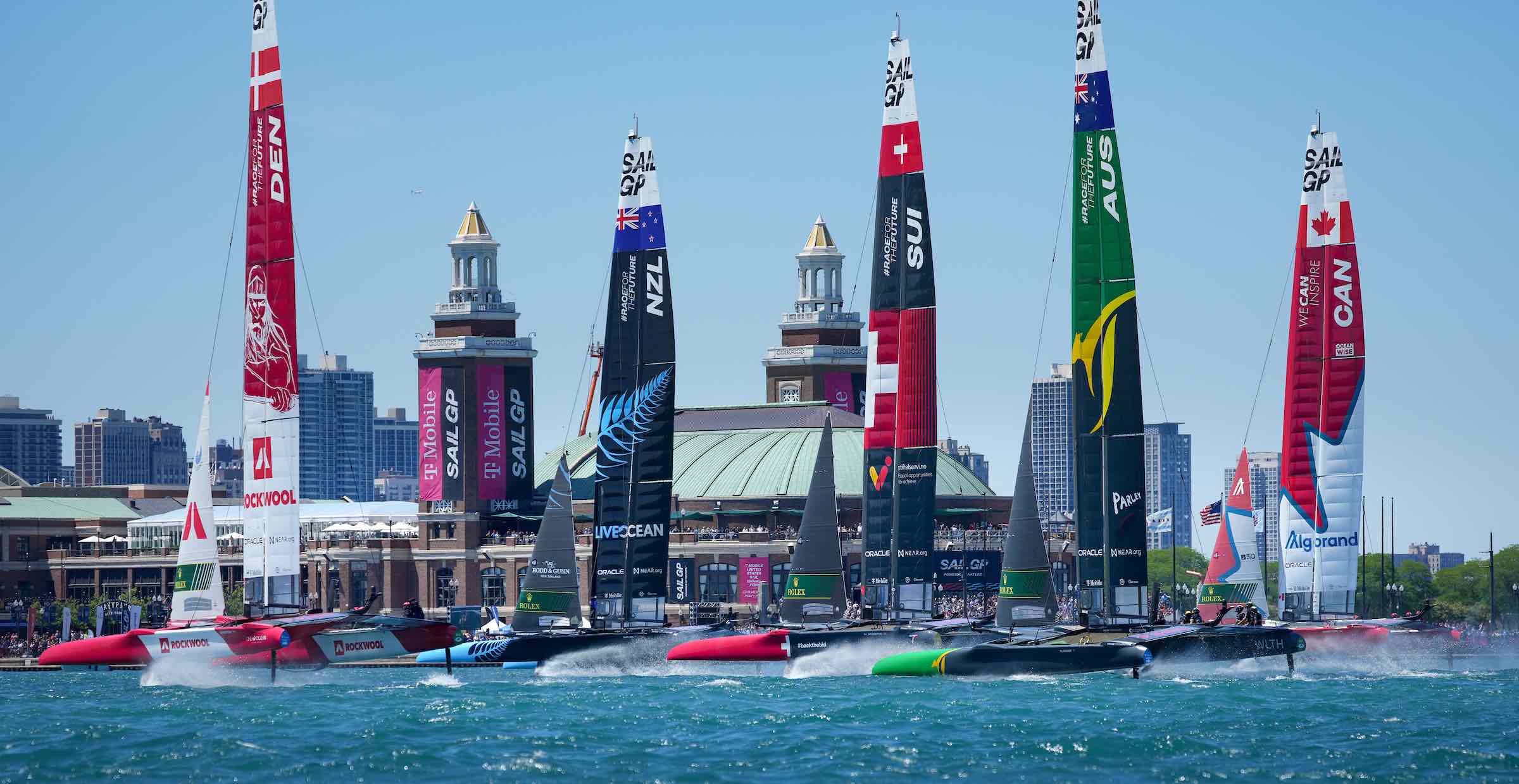Ahead of the highly anticipated Dubai Sail Grand Prix presented by P&O Marinas, on 12 and 13 November, we set sail to SailGP Cadiz in Spain.
Cadiz is one of the oldest cities in Spain and is viewed by many as the centre of Spanish naval pride since the 18th century, making it the perfect location for the Spanish-hosted GP on the 500th anniversary of the first voyage around the globe.
Cadiz welcomed us with its all-year-round fabulous weather and genuine Andalusian hospitality. Our hotel, Monte Puertotierra, was favourably located a stones-throw away from La Caleta Beach, making our daily twenty-minute walks to Muelle Reina Victoria, Puerto de Cadiz, memorable due to the unforgettable scenery and the city’s undeniable Spanish charm. Under the fronds of palm trees, the sun-soaked promenade offered us a view of the ocean and unmistakable Andalusian architecture from years gone by.

The beautiful esplanade led us to the narrow, colourful streets of the old city, filled with taverns, cafes, shops, and local businesses, overshadowed by houses with wrought iron balconies from which neighbours would greet each other in the morning.
At the heart of the old town lies the Mercado Central de Abastos, where the locals buy fresh fish, seafood, fruits, and vegetables. There we found traditional food stands offering everything from empanadas to traditional tapas dishes. Before heading to the port, we couldn’t help but purchase a plate of black seafood paella, complemented by a tasting of the famous local sherry for which Cadiz is very well known.
Our arrival at the SailGP Cadiz media conference was further delayed by a shameful number of “let me take a picture of this for the gram” moments along the way. On the adjacent streets, we were welcomed by blossoming trees and water fountains leading to the Plaza de la Catedral, which houses both the stunning Cadiz Cathedral and the Baroque Santiago church, built in 1635.

We finally got to the port, where we caught our first glimpse of the giant catamarans being lowered into the water. The press conference went as expected, with Australia’s Tom Slingsby (defending champions and current leaders) and New Zealand’s Peter Burling (runner-up in the leaderboard) throwing quirky jabs at each other. On the one-year anniversary of the Women’s Pathway, USA’s Jimmy Spithill took the time to acknowledge the heap of talent coming from the female athletes in SailGP. This follows the race in St. Tropez, where team USA had to use a reserve athlete (strategist Amélie Riou) borrowed from their “French friends” who as hosting team were meant to assist them with an athlete in case of any injuries. Jimmy added that “instantly you could see the level, so it’s exciting for the fleet and the future of the sport.”
Before drifting out onto the open water for some SailGP action, we’re dropping the anchor and taking you through our Tech Base Tour journey, which will shine some light on what SailGP Cadiz is all about and what makes it the future of sports.

SailGP Cadiz is one of the most exciting water sports out there and has a little something for everyone. From adrenaline junkies to socially conscious individuals and environmentalists, the championship is raising the bar for all the other international associations and federations across all sports. It redefined the sport of sailing, running under the motto of ‘Powered by Nature, Driven by Purpose and without compromise’. But what makes it so unique compared to other racing events? Let’s look at a few elements:
- Equality across the board – during the Tech Tour, we could see what these nine supercharged catamarans were really made of. SailGP runs on a one-design class model, providing all the teams with equal cutting-edge technology, thus putting the race results directly in the hands of the world athletes.
- Technology – The F50 is a new class of boat, sharing its DNA with the revolutionary catamarans used for the 35th America’s Cup in 2017. A culmination of 10 years of development in high-performance racing, led to these magnificent giants powered by a modular wing sail with three sizes, flying above the water on hydrofoils. The F50 marks a huge step forward in the evolution of the sport. From up close, one might even confuse these “flying boats” with spaceships.
- Shared data – powered by Oracle Cloud Infrastructure (OCI), the 30,000 data points coming out of an F50, are shared between all teams, allowing them to gain valuable insights into their competition and the ability to learn from each other. This allows less mature teams to quickly catch up with the leaders and push the experienced teams out of their comfort zones, forcing them to innovate and constantly look for ways to improve.
- Women’s pathway – SailGP has created an inclusive sporting championship with gender equity at its heart. Every team is required to race with a female athlete on board and hold selection camps to identify and include other female athletes in training. Teams are also incentivized through the Impact League to fast-track their development in both training and racing. The Spanish Grand Prix marked the one-year anniversary of the Women’s Pathway, and female athletes were asked to share their thoughts on the past year and what impact it had on their careers. Here are some of our favourite answers: Isabella Bertold from Canada SailGP Team said, “One of my favourite quotes is ‘if you can see it, you can be it’. The Women’s Pathway provided a foundation for women to purse professional sailing at the highest level, and now we can be role models and inspire the next generation.” Nina Curtis, Australia SailGP Team added: “The Women’s Pathway has opened the door for female sailors into this aspect of sailing that has previously been closed. I hope the next generation of female sailors finally feel represented at this level of sailing and chase their dreams. It’s going to be a big fight, but we are making the first big steps and it’s an exciting time to be a female athlete in this sport – the tide is turning.” We are excited to see what the future of Sailing looks like with such a strong pole of female athletes coming on board.
- Impact league – during our tech tour, we learned about a second leaderboard that runs in parallel with the Season Championship. Teams are competing to increase their positive actions, reduce their overall carbon footprint and help accelerate inclusivity in sailing. External auditors review the teams based on several criteria starting from sustainability impact, inclusiveness, innovation, carbon footprint and others. The leader of each event is the first to have their boat in the water, allowing them to set it up and test it for longer. Team Denmark came in as a leader in Spain, after some of its athletes cycled from St. Tropez to Cadiz, significantly reducing their team’s carbon footprint.
- Race format – nothing is left to chance in SailGP, and to win a Grand Prix, teams need to be consistent all weekend long. Teams compete in three 15-minute events each day, resulting in a final for the top three teams after six events. This means teams have limited time to adjust to new strategies between races, leaving little room for errors. On top of that, an event win does not guarantee a seat in the top three final. To put it in perspective, day one did not find a team winning more than one event.
- Experience – seeing race cars and speed boats take sharp corners will forever be impressive but looking at a 29m catamaran that can reach top speeds of 100kmph whilst performing sharp manoeuvres over the choppy water is a whole new game. Looking at the crew, we noticed that the traditional sailing attire has been replaced by something close to what Formula1 drivers or Jet Fighter pilots would wear. An outfit suitable for the most elite athletes, able to fly these technological marvels. In fact, each team has a Flight Controller assigned to keep the boat flat and in the air. To achieve that, we saw them constantly communicating with the Wing Trimmer, who is responsible for generating as much power as possible and using it in the best possible way. We then look ahead at the front of the boat, where we find two Grinders, perhaps the bulkiest athletes on every F50, who ensure the sheet is used as effectively as possible. We then notice the one who controls everything, the Driver in charge of all the crew decisions.

In Cadiz, a city known for its sailing heritage, tens of thousands of Spaniards gathered to support the home team, cheering for each manoeuvre from the Race Village or the anchored yachts close to the action. At the end of each day, as we returned to Tech Base, the Spanish F50 was escorted by a fleet of fans. An image reminiscent of the iconic scene in the 2015 movie Mad Max Fury Road.
Behind the scenes, we’ve witnessed athletes enjoying their time in Cadiz, either by visiting the city, playing catch in the team’s tent or completing a number of fun challenges organised by SailGP.
After two days and six races, we had the pleasure of witnessing the closest-ever finish in SailGP history, with team France coming one sailboat or three seconds ahead of team USA to clinch the race. The third spot on the podium was taken by the Aussies after a catchup race, caused by an aggressive match tactic from team USA early in the race.
The SailGP Cadiz presented by P&O Marinas will now head to Dubai on the 12 and 13 November. What are your predictions for Dubai?
GO: Visit sailgp.com/dubai to purchase tickets or for more information.


